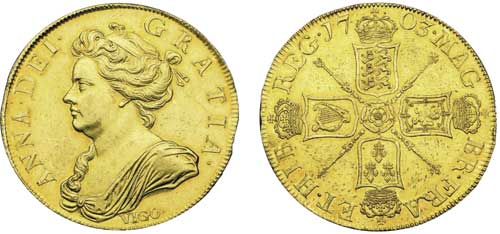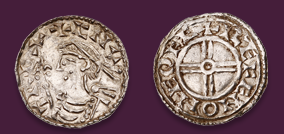
Auction: 5028 - The Samuel King Collection of Highly Important British Gold Coins
Lot: 142
xAnne (1702-14), the celebrated Vigo Five Guineas, 1703, vigo. provenance below first draped bust left, anna.dei. gratia., the vigo. with double struck I, toothed border both sides, rev. inverted die axis, Pre-Union crowned cruciform shields, semi-frosted inner rings to small crowns, the English crown with small stop to upper right, eight strings to Irish harp, sceptres in angles, rose in centre, date at top, J type 1, .mag br.fra et.hib reg., edge upright inscription in raised letters .+decvs.et.tvtamen .anno.regni.secvndo. (Schneider 523; MCE.197; S.3561), scratch in field behind bust, other light hairlines on neck and with patch of metal striations on upper chest and in front of bust, reverse with similar striations, a few rim imperfections at edge collar meeting points, otherwise very attractively toned, extremely fine, very rare and one of the most desirable coins in the entire milled series Estimate £ 40,000-50,000 Capt. K J Douglas-Morris, Sotheby, 26 November 1974, lot 12Sharps Pixley Collection, Spink Coin Auction 72, 9 November 1989, lot 58On the October 12th 1702 a powerful Anglo-Dutch fleet, under the command of Admiral Sir George Rooke, engaged and destroyed a Franco-Spanish bullion fleet sheltering in Vigo bay on the north-eastern coast of Spain. Rooke´s fleet was returning to England after a failed attempt to take the port of Cadiz following the outbreak of hostilities in what was to become the War of Spanish Succession. Despite achieving near total victory the English and their allies, as a result of Spanish foresight, only recovered a modest quantity of precious metals of which less than 4,500 lb of silver and the paltry sum of 7lb and 8oz of gold made it to the Mint. The destruction of the enemy fleet inflicted a serious blow to the reach of French naval power and the significance of the action was clearly perceived at the time.1 The bullion was transported to the Tower with considerable pageantry and the then Master of the Mint, Sir Isaac Newton, noted for his frequent absences, personally oversaw the delivery. A royal warrant was subsequently issued causing the bullion to be coined and the word ´VIGO´ to be inserted under Queen Anne´s bust in order to ´Continue to Prosterity the Remembrance of that Glorious Action.´ 2 The VIGO gold issue of 1703 was intended for circulation and comprised Half Guinea, Guinea and Five Guinea pieces. The dies were the work of the Mint´s Chief Engraver, Henry Harris and his assistant John Croker. Each denomination is excessively rare and while exact numbers struck are unknown it is believed that fewer than 15 Five-Guinea pieces are in private collections. According to our records only four other examples have been offered at auction in Britain in the past 45 years. The VIGO Five Guinea piece is one of the most desirable coins in the entire English milled gold series.1 For a detailed account of the battle and its consequences see H. Kamen, ´The Destruction of the Spanish Silver Fleet at Vigo in 1702´, Numismatic Circular, June 19682 C. Challis (ed.), A New History of the Royal Mint, Cambridge, 1992, p.433
Sold for
£130,000




